Peperomia, home care for which a beginner grower is able to, is a representative of the tropical zones of South America. The flower, with its inherent decorative appeal, is ideal for creating an exotic atmosphere in a city apartment.
Material Content:
Care and maintenance of Peperomia at home
Caring for peperomia in an apartment environment is not particularly difficult, however, it has a number of nuances.
The soil

To ensure the natural ventilation of the root system of peperomia, it is necessary to use loose soil. You can prepare the soil mixture by mixing sheet soil, compost, peat, sand in a ratio of 2: 1: 1: 1 or sheet soil, peat and sand in equal proportions. The plant prefers slightly acidic or neutral soil.
Caution! Heavy compacted soil reduces the access of oxygen to the roots, which leads to their decay.
Lighting
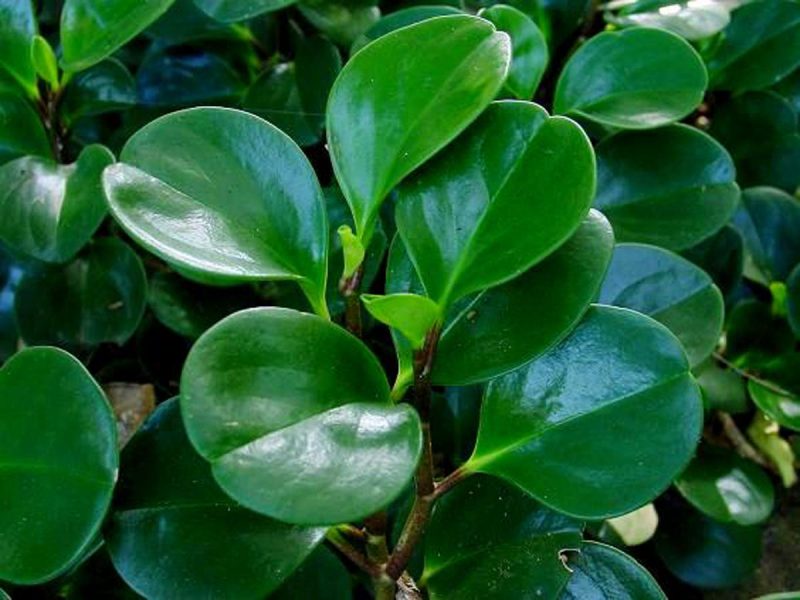
Depending on the type of flower, the requirements for the quantity and brightness of lighting may differ:
- Varieties with dark green foliage can be cultivated in rooms with northern windows.
- Variegated leaves require bright lighting, especially during the winter season.
But regardless of species, culture needs protection from direct sunlight from the summer.
Important! With a deficit of light, flower shoots cover underdeveloped and faded leaf plates.
Humidity
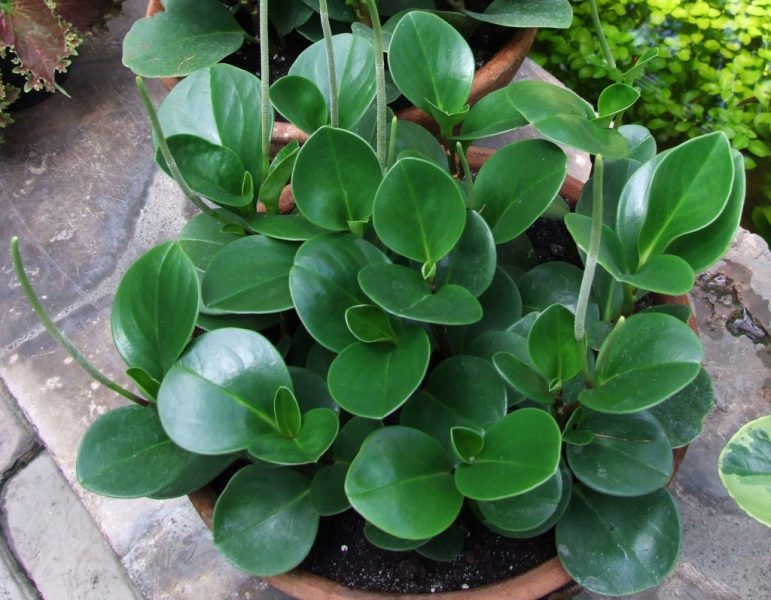
Moisture level is not a significant indicator. In the natural environment, the plant grows at high humidity, but dry air masses in apartments do not inhibit the culture. Peperomia, in addition to species with lowered and folded foliage, will be grateful for additional spraying in the summer months.
Temperature
The tropical origin of peperomia led to her love of heat and intolerance to drafts. In the spring-summer period, the optimal temperature regime for the full growth of the plant is 20-22 ° C. In the winter season, the mercury column of the thermometer in the room should not fall below a value of 16 ° C, and the temperature of the substrate should exceed 17 ° C.
Advice! In winter, it is better not to contain the flower on a cold windowsill: it can stop growing.
Watering
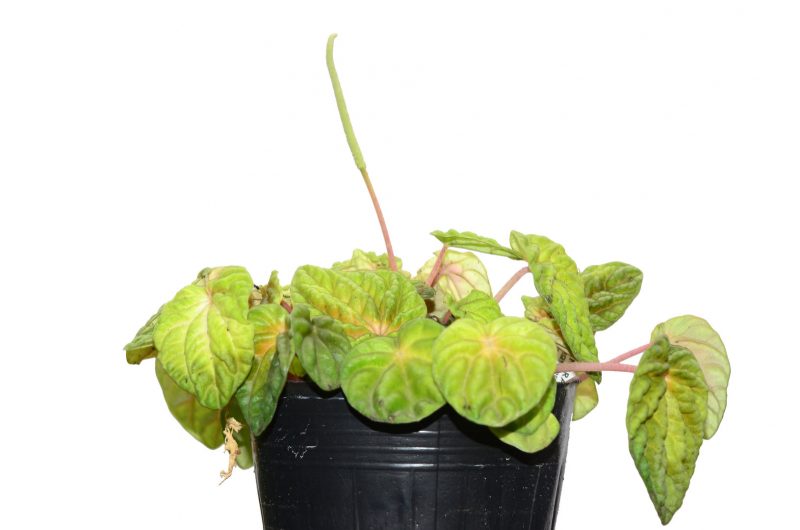
Moderate hydration of peperomy is carried out during the growing season. With the advent of autumn, it gradually decreases, and in winter it is reduced to a minimum. The plant is poured with settled water, which should be 2-3 ° warmer than the air temperature in the room.
Caution! Excessive moisture can cause rotting of the shoots and root system.
Fertilizer application
To feed exotic representatives, complex mineral fertilizers are used for decorative indoor plants, a wide range of which are presented in flower shops. During the active growth phase, additional nutrition is carried out twice a month according to the instructions on the package. At rest, the flower is fed no more than once a month.
Transfer
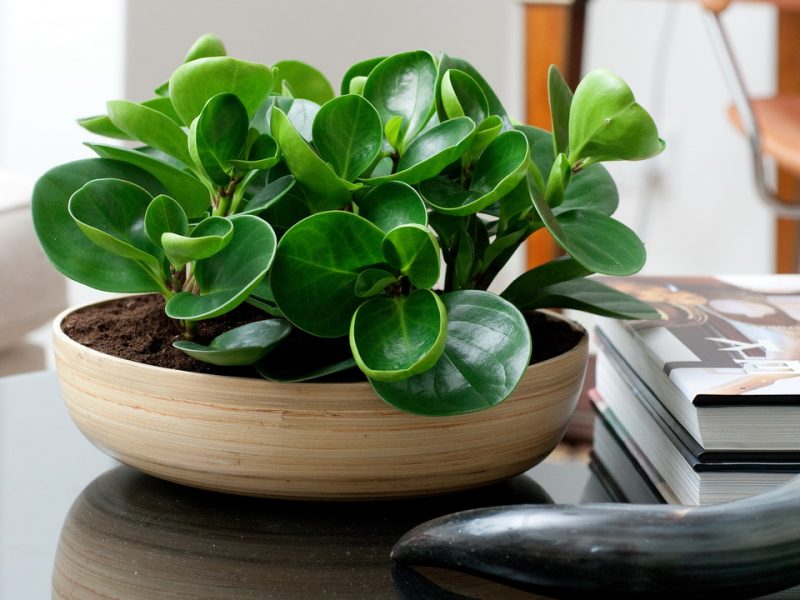
As necessary, as a rule, withstanding a two-year interval, the plant is transplanted: the growth rate of peperomy is characterized as slow. But with a complete halt to the development of a healthy specimen, it is worth examining the drainage holes for the presence of roots in them. Due to the compactness of the rhizome, the culture is planted in a small pot, on the bottom of which a 6 cm drainage layer of fine expanded clay is necessarily placed.
The nuances of care depending on the type of flower Peperomia
The genus has about 1000 fairly diverse species, distinguished by decorativeness and beauty. The most popular among the varieties that can be cultivated at home, are about a dozen.
Pepperomy wrinkled
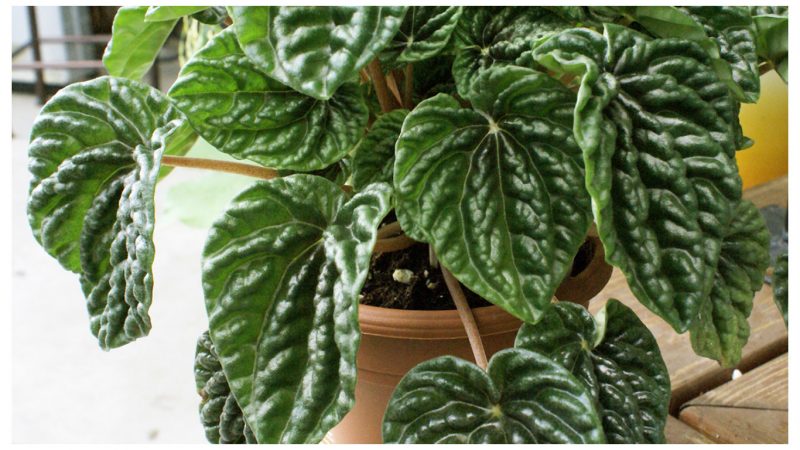
Among the species diversity, an unusually flowering native of Brazil, peperomia shriveled, is perfect for cultivation in a room environment. A short plant up to 10 cm tall with petiole sessile leaf plates resembling rosette. Petioles painted in silver color with a pinkish tint, perfectly combined with green foliage, distinguished by brown veins, concave on the outside and convex below. Flowering is observed in the summer season with the formation of spike-shaped erect inflorescences of white color. For breeding the species, cuttings are used, which is best done in early spring.
It is interesting:Gloxinia Care
Peperomy
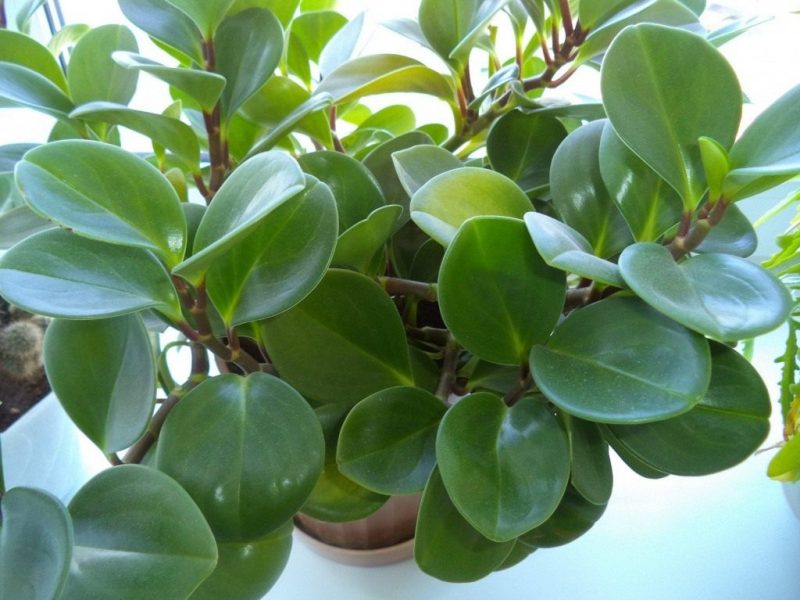
The species is represented by herbaceous perennials growing both on the ground and on trees. Undescended stems are alternately covered with petiolate dark green oval leaves with a narrowed base and a reddish-brown frame. The fleshy leaf plate reaches a maximum length of 12 cm, a width of 6 cm. Green flowers are collected in inflorescences. The flower is photophilous, represented by many varieties.
Peperomia Lilian
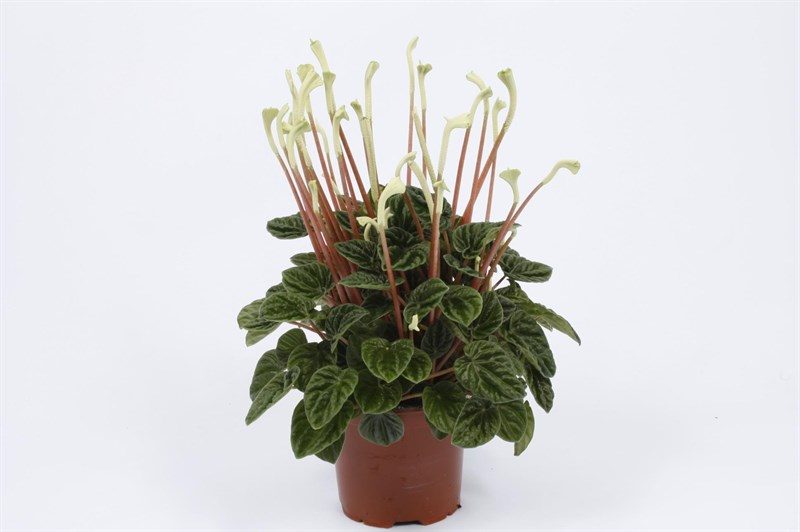
The species is distinguished by large foliage with light veins and unusual inflorescences formed on fairly high peduncles of pink tones. The name of the species is due to the original form of inflorescences, expanding to the upper part, like lilies. To achieve better branching, the shoots are nipped.The flower prefers shaded places, which makes it easy to grow.
Peperomia magnolia

A flower with oval short-leaved leaves located on fleshy stems reaches a height of 30 cm. On average, the diameter of the leaf with a smooth, waxy surface is 5 cm. Depending on the variety, the color can be plain green with light or dark tones, as well as colorful with contrasting splashes, divorces or stripes. Flowering is an inconspicuous sight: spikelets are formed, resembling inflorescences of plantain.
Golden leaf peperomia
The appearance is distinguished by the extraordinary color of the leaves: the surface of the dark green glossy leaf has a pattern of golden yellow spots.
Peperomia creeping
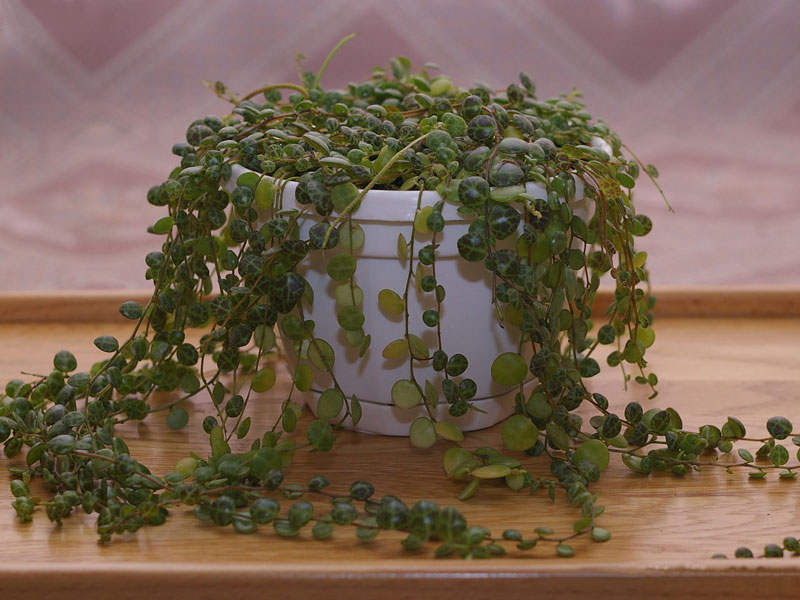
The shape of the plant with rounded foliage of 1 cm does not cover the reddish stems so thickly compared to another representative of the ampelous species - peperomeria chrysophila. The coloring of the sheet plates impresses with the variegated pattern, consisting of silver and bronze spots.
Peperomia climbing

Representative of tropical forests with pinkish-green stalks, on which leaves are 5 cm oval with pointed ends. If you build a strong support, the plant can be cultivated as a lianoid form.
Peperomia Klusielistnaya
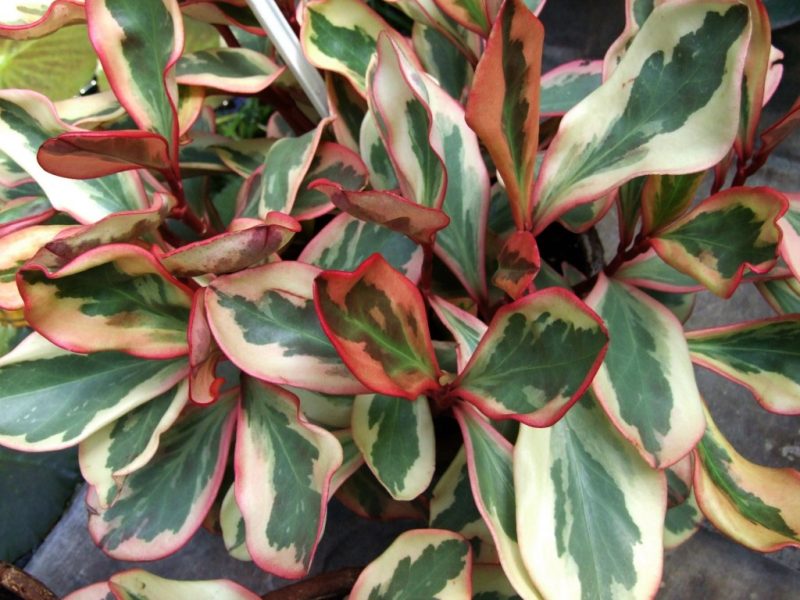
Large plant, thick shoots of which stretch up. Dense dark green leaves with a red tint are covered with a matte coating, and on the edge are framed by a dark purple border.
Plant propagation
Representatives of the genus reproduce without much difficulty. For this purpose, seed and vegetative methods are used. Regardless of the selected actions, the best time for the procedure is spring.
- Seed method. The reception does not allow to maintain varietal qualities, which is why it is not popular.
- Division of the bush. A common method used when transplanting is carried out by separating tubers. After separation, the sections are necessarily treated with an antiseptic agent in the form of charcoal or activated carbon, which helps to prevent infection and the development of a wide range of harmful microorganisms.
- Cuttings. The most popular method, in which the upper part of the shoot is cut off in the middle of the spring season and rooted in plain water with a small amount of charcoal to inhibit the development of infections. When the first roots appear, young cuttings are planted in the prepared substrate.
Pests and Diseases of Peperomia
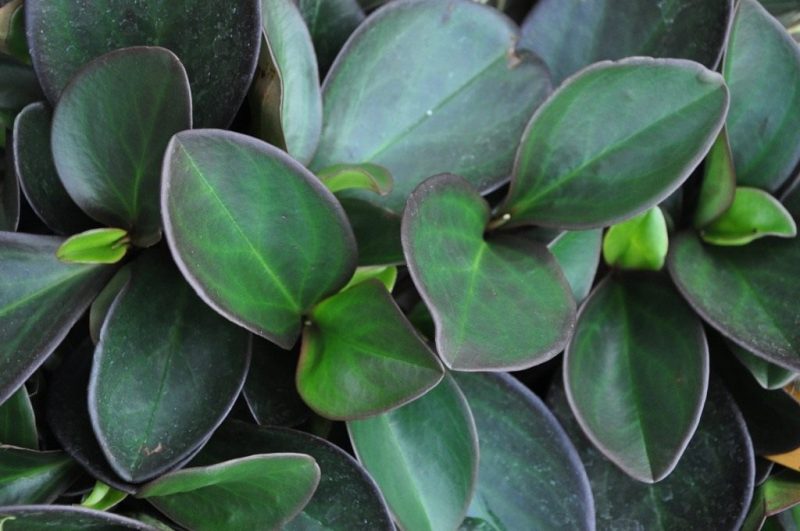
Culture is often affected by such pests:
- spider mite. In conditions of very low humidity, which can be avoided by regular spraying, a cobweb is observed when inspecting the stems in the internodes. After its appearance, the leaves weaken and fall. Measures to combat parasitic insects consist in wiping the shoots with a sponge dipped in soapy water and rinsing under the shower. In case of strong settlement, the plant is treated with a solution of the insecticidal drug Actellic at the rate of 1-2 ml per 1 liter of water or another analogue according to the instructions.
- thrips. With high temperature and dry air, the appearance of thrips is also possible. Colonies are deposited on the back side of the leaf plate by the pest, which leads to the formation of light specks on the upper side. The result is a brown foliage with a gray tint. Species with variegated colors need careful examination: spotty coloring makes it difficult to identify. You can deal with the pest by spraying with an insecticide.
- mealybug. When a flower is damaged by a pest, the leaves need to be rubbed with an alcohol composition using a cotton swab.
It is interesting: mealybug: how to fight on indoor plants
Among the diseases, rot of the roots and root neck are distinguished, the fungal infections serve as the impetus for their manifestation.The latter develop intensively in the case of too compacted or regularly waterlogged soil. As protective measures, you can apply a flower transplant into a new soil with reduced irrigation.
So, peperomia is a beautiful elegant decorative flower, for which it is easy to provide the necessary conditions for growth. In response, the plant will thank the owner by isolating a large number of volatile, cleansing the air in the room from harmful microorganisms.












